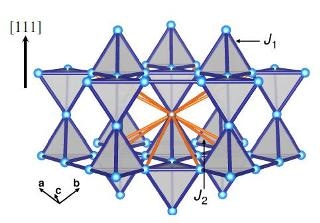Jan 23 2019
For the first time, an international team of researchers has successfully used an innovative computational technique to systematically investigate magnetic quantum effects in the renowned 3D pyrochlore Heisenberg model. The fascination outcome of the study is that physical quantum phases are formed only for smaller spin values.
 The model refers to a cubic crystal structure (pyrochlore lattice). Not only were magnetic interactions between the nearest neighbours included, but also with the next nearest neighbours (see drawing). (Image credit: HZB)
The model refers to a cubic crystal structure (pyrochlore lattice). Not only were magnetic interactions between the nearest neighbours included, but also with the next nearest neighbours (see drawing). (Image credit: HZB)
In crystalline solids, molecules and atoms are arranged in regular three-dimensional lattices. The interaction of atoms with one another takes place through various forces, eventually reaching a state of lowest energy. Close to temperatures of absolute zero, the lattice oscillations freeze, letting the interactions between electron spins to dominate. A specifically fascinating phenomenon takes place when all the spins are unable to align at the same instance to reach a state of minimum energy. This leads to a frustrated system where the spins are almost entirely disordered and are hence called as a spin liquid.
Cubic Crystal Structure
The Heisenberg pyrochlore lattice model—a simple cubic crystal structure—is one of the principal models for analyzing 3D frustrated quantum magnets. However, to date, it has been very challenging to derive practical estimations, that is, for particular materials and temperatures, from this theoretical model.
Different Spin Values
Currently, research teams from Germany, Canada, Japan, and India have collaboratively performed systematic analyses of this model using an innovative theoretical method and overcome a number of these challenges. Using this new method, it is feasible to change the spin value of the lattice atoms and even the temperature and other interaction parameters, as well as to calculate the parameter ranges in which innovative magnetic quantum effects take place. The calculations were performed at the Leibniz Supercomputing Centre (LRZ) in Munich.
Quantum Effects Only for Small Spins
“We were able to show that quantum physical effects surprisingly only occur over very limited parameter ranges”, explained Prof. Johannes Reuther, theoretical physicist from the HZB, co-author of the study. These quantum effects are highly marked at the smallest possible spin vale of ½. However, spin systems in the crystal structure analyzed by the researchers already behave virtually analogous to classical physical systems at spin values of 1.5 and above.
The published study offers deeper insights into solids and plays a vital role in the systematic advancement of the quest for 3D spin fluids in quantum materials.